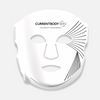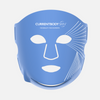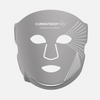|
Bestseller
 Red Light
Red Light
|
 Blue Light
Blue Light
|
New
 Multi Light
Multi Light
|
|
|---|---|---|---|
| £399.99 | £399.99 | £499.99 | |
| Anti-ageing | |||
| Fine lines & wrinkles Red (633nm) | |||
| Tighten, brighten, balance Near-Infrared (830nm) | |||
| Deeper collagen boost Deep NIR (1072nm) | |||
| Anti-blemish | |||
| Clear blemish bacteria Blue (415nm) | |||
| Redness & Pigmentation | |||
| Fade pigmentation Green (532nm) | |||
| Skin tone & circulation Yellow (590nm) | |||

LED Red Light Therapy Face Mask: Series 2
LED Red Light Therapy Face Mask: Series 1
LED face mask for advanced anti-ageing
3 Highly Precise Wavelengths Best Fit For Every Face Guaranteed Quality, Safety & ResultsThe most trusted LED face mask for visible anti-ageing
Tried & Trusted Anti-Ageing Technology 2 Clinically Proven Wavelengths Original Flexible LED Mask- We accept:
- More
Delivery Methods
60-Day Money Back Guarantee
For a change of mind return, your item must be unused and in the same condition that you received it. It must also be in the original packaging with all seals intact.
Money Back Guarantee: If within 60 days you are not completely satisfied with your item, you can return the item and receive a refund minus a ten percent restocking fee.
Two Years Warranty: You are eligible for a full refund if your item proves to be faulty within six months, we also cover the return cost. Should your item prove to be faulty after six months, you are eligible for store credit or exchange only.
What you need to know:
- Red light therapy boosts collagen production for younger-looking skin, reducing wrinkles by 30% and improving plumpness by 57% in 8 weeks*
- 3 highly precise wavelengths: red (633nm), near-infrared (830nm) and deep near-infrared (1072nm)
- Best-fit flexible silicone shape designed for optimal full-face coverage
- Veritace® guarantee ensures the highest level of testing for maximum results. Learn more here
- 60-Day Money Back Guarantee Not completely satisfied? Find out more
What you need to know:
- Red light therapy mask trusted to reduce the signs of ageing - reduces wrinkles, evens skin tone and smooths skin texture
- Gives you a healthier, brighter and smoother complexion
- Treats with the 2 clinically recognised wavelengths: red (633nm) and near-infrared (830nm)
- Flexible silicone shape
Product and packaging design may vary slightly from images.
Independent Clinical Trials Report 2024
Real Results
LED Red Light Face Mask before and afters
See the difference our clinically proven devices make. We don’t just promise results, we prove them.
Real Results
LED Red Light Face Mask before and afters
See the difference our clinically proven devices make. We don’t just promise results, we prove them.
Proven to reduce the visible signs of ageing
236 LEDs emit the 3 most clinically recognised wavelengths for anti-ageing, penetrating up to 10mm into the skin:
- Red light (633nm): Boosts collagen production, reducing fine lines and wrinkles
- Near-infrared (830nm): Energises cells to firm, tighten and brighten skin
- Deep near-infrared (1072nm): Targets areas where signs of ageing are more pronounced, boosting collagen production deep under the skin.
See less lines and wrinkles and firmer, brighter and smoother skin in just 4 weeks. Treatments are completely painless and take just 10 minutes.

Understand the upgrades
This red light therapy mask has extra LED bulbs in an improved layout and an added chin strap for better, full-face light coverage, while new deep near-infrared light supercharges results. Now even easier and more comfortable to use:
- Best-Fit flexible liquid silicone contours to every face for improved coverage
- New multiway strap for a secure fit and maximum comfort
- Clip-on controller makes it easier to use on the go
- Optional eye inserts to make reading, scrolling, or watching TV with your device on even easier
Each facial LED mask features a unique Veritace® NFC card – simply tap the card inside the box to see every stage of quality testing your red light mask has undergone.

Clinically recognised LED wavelengths
132 LEDs emit the 2 most clinically recognised wavelengths for anti-ageing:
- Red (633nm): Boosts collagen production, plumping the skin and smoothing lines and wrinkles.
- Near-infrared (830nm): Energises cells for a firmer and tighter complexion.
Penetrating up to 4mm into the skin, these wavelengths reach deeper than even retinol, for more impressive results.

Trusted to reduce the visible signs of ageing
This LED red light mask is a non-invasive answer to tighter, brighter and smoother skin, proven to deliver visible anti-ageing results with 10-minute treatments.
Combine LED mask treatments with your favourite skincare products to supercharge results. The CurrentBody Green Tea Serum and Hydrogel Face Masks deeply hydrate the skin and boost the benefits of facial light therapy.


Proudly Awarded

Your questions, answered
Our in-house beauty tech experts answer your most commonly asked questions.
The LED Light Therapy Mask Series 2 has 236 bulbs:
110 red (633nm) LED bulbs
110 near-infrared (830nm) LED bulbs
16 deep near-infrared (1072nm) LED bulbs
Refer to comparison table. 
This wavelength has more recently been shown in scientific evidence to be highly effective for skin renewal and wrinkle reduction, penetrating up to 10mm into the hypodermis to stimulate collagen production deep below the surface of the skin.
Power alone doesn’t determine the effectiveness of LED masks. In fact, excessive power could harm the skin, while lower power over a longer period often delivers the best results. To determine the quality and effectiveness of an LED mask, it’s important to also look at the wavelength precision, LED light coverage and treatment time.
Despite having the same power density (or irradiance) as the original mask (30 mw/cm²) and a convenient 10-minute treatment time, the Series 2 LED Mask is designed to offer unmatched wavelength precision and coverage for optimal results. The graph below illustrates how these enhancements give a more even and consistent treatment across the full face compared to a standard flexible LED mask. To learn more, read the blog ‘Why Power Alone Doesn’t Determine the Effectiveness of LED Masks'

We created Veritace®, our unique end-to-end production & testing system, to guarantee that only the most precise LEDs power our technology.
Behind the quality of every Veritace® device is the highest level of testing to ensure maximum results for your skin. Learn more here
Click to watch the how to video here
Refer to comparison table. 
Before carrying out your first treatment you must carry out a sensitivity test. Follow the step by step guide below;
1. Power on your device.
2. Switch ON the controller and allow the device to run for its full 10-minute treatment program. The device will automatically switch off after 10 minutes.
3. At any time if your skin feels HOT or uncomfortable STOP using the device immediately.
4. After the treatment wait at least 6 hours. If the skin appears red and/or itchy the device is unsuitable for you and in these circumstances you can return the device to us within 14 days for a full refund.
Certification: UKCA registered
Power Input: 100-240Vac / 50-60Hz
Power Output: 5.0V-1.0A
Product Weight: 350g
Dimensions: W 429mm x L 197mm x H 5mm
Energy Source: LEDs
Wavelengths: Red (633nm), near-infrared (830nm)
Number of LEDs: 66 red, 66 near-infrared
Power Source: Lithium Ion Battery
Power Density: 30mW/cm²
Treatment Time: 10 minutes, 4 times per week
Operating Environment Temperature: -10-35˚C
Operating Environment Humidity: 30-90%RH
Storage Environment Temperature: -20-60˚C
Storage Environment Humidity: 30-90%RH
DO NOT use this device to treat any other conditions apart from those listed in the indications for use. This device has not been tested for any other conditions than those listed, and the risk is unknown.
DO NOT use this device if you are pregnant, planning on becoming pregnant or breastfeeding. This device has NOT been tested on pregnant or breast-feeding women and therefore the risk to the foetus, neonate or pregnant women is unknown.
DO NOT use this device if you suffer from Lupus erythematosus, photosensitive eczema or Albinism. If you use this device system to treat Lupus erythematosus, photosensitive eczema or Albinism you may cause a severe skin reaction.
DO NOT use this device if you suffer from any photosensitive disorder (sensitisation to light). If you use this device and you suffer from a photosensitive disorder you may cause a severe skin reaction.
DO NOT use the device if you suffer from light-induced headaches.
DO NOT use the device if you suffer from any genetic conditions of the eye.
DO NOT use this device if you are taking any medication that can cause photosensitivity. If you use this device and you are taking any medication that can cause photosensitivity you may cause a severe skin reaction. Photosensitivity is a common side effect of various medications. These can include certain antibiotics, chemotherapy drugs, and diuretics. If you are unsure about any medication you may be taking consult your healthcare provider. Other substances not listed above can also cause photosensitivity. Common examples of these substances are St John's Wort, Coal tar, deodorants, antibacterial soaps, artificial sweeteners, naphthalene (moth balls), petroleum products, brightening agents found in laundry detergent, and cadmium sulphide (a chemical injected into the skin during tattooing.

Need some help?
Our friendly experts are here to help you to find your perfect beauty device.
View more products
Recently viewed
Shop the items you have recently viewed.
- Translation missing: en.accessibility.refresh_page

























































